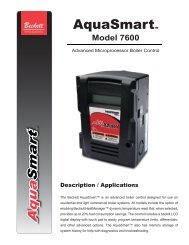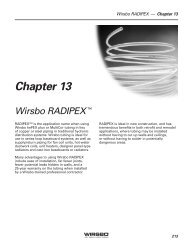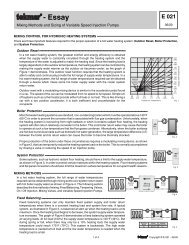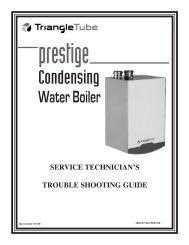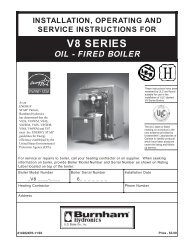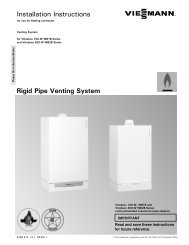Steam Locomotive Firebox Explosion on the Gettysburg Railroad ...
Steam Locomotive Firebox Explosion on the Gettysburg Railroad ...
Steam Locomotive Firebox Explosion on the Gettysburg Railroad ...
Create successful ePaper yourself
Turn your PDF publications into a flip-book with our unique Google optimized e-Paper software.
supplies water to <strong>the</strong> boiler indirectly<br />
through <strong>the</strong> feed-water heater. The feedwater<br />
heater is a heat exchanger that absorbs<br />
heat from used cylinder exhaust steam that is<br />
o<strong>the</strong>rwise lost up <strong>the</strong> exhaust stack. The<br />
feed-water heater is more efficient when <strong>the</strong><br />
locomotive is moving because <strong>the</strong>re is more<br />
exhaust heat and steam.<br />
The engineer c<strong>on</strong>trols <strong>the</strong> injector with a<br />
knob <strong>on</strong> his side of <strong>the</strong> cab. The fireman<br />
c<strong>on</strong>trols <strong>the</strong> feed-water system with a pumpc<strong>on</strong>trol<br />
valve that is <strong>on</strong> his side of <strong>the</strong> cab.<br />
After <strong>the</strong> accident, <strong>the</strong> injector was found<br />
closed, and <strong>the</strong> feed-pump c<strong>on</strong>trol valve was<br />
found open 1 1/2 turns. The amount of water<br />
<strong>the</strong>se devices supply to <strong>the</strong> boiler depends<br />
<strong>on</strong> boiler demand, so <strong>the</strong>ir valve c<strong>on</strong>trol or<br />
knob positi<strong>on</strong>s do not indicate whe<strong>the</strong>r a<br />
sufficient amount of water is being provided.<br />
It is <strong>the</strong>refore critical for <strong>the</strong> fireman to<br />
closely m<strong>on</strong>itor <strong>the</strong> water glass and/or gage<br />
cocks.<br />
After <strong>the</strong> accident, <strong>the</strong> CMO of <strong>the</strong><br />
Valley <strong>Railroad</strong> at Essex, C<strong>on</strong>necticut,<br />
examined <strong>the</strong> injector of locomotive 1278<br />
and reported:<br />
Up<strong>on</strong> entering <strong>the</strong> cab of <strong>the</strong><br />
locomotive…I found that <strong>the</strong> turret<br />
valve for <strong>the</strong> injector was shut off.<br />
Later <strong>on</strong> <strong>the</strong> next day, <strong>the</strong> steam valve<br />
of <strong>the</strong> injector itself was disassembled<br />
to see if any problem could be found.<br />
Up<strong>on</strong> disassembly, it was found that<br />
<strong>the</strong> steam valve disk inside <strong>the</strong> injector<br />
was not <strong>the</strong> correct steam valve disk<br />
for that model injector. The Edna Type<br />
L lifting injector has to prime to get<br />
water up into <strong>the</strong> body of <strong>the</strong> injector.<br />
To do that, <strong>the</strong> steam valve disk has a<br />
protrusi<strong>on</strong> <strong>on</strong> <strong>the</strong> end of it which<br />
allows when opened just a little bit of<br />
steam to come by that protrusi<strong>on</strong> and<br />
enter <strong>the</strong> annular nozzle, which creates<br />
a vacuum which raises <strong>the</strong> water. The<br />
disk that we found inside <strong>the</strong> 1278’s<br />
injector did not have that protrusi<strong>on</strong>.<br />
Therefore, when <strong>the</strong> steam valve was<br />
opened, it would be very difficult to<br />
prime <strong>the</strong> injector. If a lifting injector<br />
cannot prime, it cannot operate. Now,<br />
it’s possible that <strong>the</strong> injector might<br />
functi<strong>on</strong>, but <strong>on</strong>ly with some<br />
difficulty.<br />
According to <strong>the</strong>ir testim<strong>on</strong>y, n<strong>on</strong>e of <strong>the</strong><br />
train crewmembers were aware of <strong>the</strong> need<br />
for a specific disk type in <strong>the</strong> injector.<br />
Water Treatment--Water used in boilers is<br />
frequently treated with chemicals and<br />
processes to minimize <strong>the</strong> buildup of scale<br />
inside <strong>the</strong> boiler and inside all <strong>the</strong> o<strong>the</strong>r<br />
devices that come in c<strong>on</strong>tact with <strong>the</strong> steam<br />
and boiler water. Treating <strong>the</strong> water also<br />
reduces corrosi<strong>on</strong> and maximizes heat<br />
transfer. Water-m<strong>on</strong>itoring and -supply<br />
systems are dependent <strong>on</strong> <strong>the</strong> free flow of<br />
water and do not work correctly if <strong>the</strong><br />
boilers and <strong>the</strong>ir attached devices are not<br />
free of scale. Thus <strong>the</strong> cleanliness of <strong>the</strong><br />
boilers and devices has safety implicati<strong>on</strong>s.<br />
Depending <strong>on</strong> <strong>the</strong> source of <strong>the</strong> water, it<br />
can be softened shortly before it is put into<br />
<strong>the</strong> tender, or it can be treated while it is in<br />
reservoirs and holding tanks. Safety Board<br />
investigators explored <strong>the</strong> nature of water<br />
treatment used by <strong>Gettysburg</strong> Passenger<br />
Services.<br />
During testim<strong>on</strong>y, <strong>the</strong> investigator from<br />
<strong>Gettysburg</strong> Passenger Services was asked if<br />
<strong>the</strong> company had water-treatment facilities.<br />
He replied:<br />
Well, I saw some evidence of water<br />
treatment. There were some empty<br />
c<strong>on</strong>tainers around. But we saw no<br />
30



